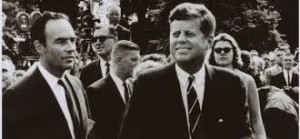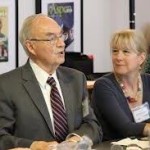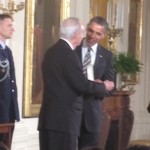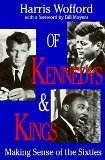The Peace Corps and America's Most Serendipitous Man: Harris Wofford
The November 2014 special issue of the New Republic is their anniversary issue (One Hundred Years of Politics & The Arts) that features articles on America’s great and infamous, and has much to my delight (and to all of us who were with him in the Peace Corps in Ethiopia) an article written by Jason Zengerle, the senior editor at The New Republic entitled, “Wofford Was Here: The Twentieth Century’s most Serendipitous Man.”
Spotting it today when the magazine arrived in the mail I thought: Well, it’s about time.
There are two photographs, one of Harris with Kennedy on the White House lawn greeting PCVs training in Washington, D.C. in the summer of ’62. (Those PCVs just happen to be the Ethiopia I Volunteers) and another photograph of Harris and his wife Clare and Bill Clinton and Al Gore in the Oval Office.
The article charts Wofford’s long life, some 88 years, going first to Tennessee and his birth to his childhood in Scarsdale, New York, to the fated trip around the world that he took at the age of eleven with his grandmother.
Zengerle writes, “What started as a boyhood curiosity ended up changing the course of Wofford’s life, and countless others.”
How true that is.
Harris as a high school teenager creating Student Federalists which advocated for united world government. By the time he was 18, Newsweek magazine predicted Harris would one day be president of the United States. For that experience, and his Air Force WWII years, would come his first book, It’s Up To Us.
After college in the University of Chicago’s Great Books program and military service, Harris would leave Yale Law School to become the first white student to enroll at Howard University Law School. Then he would visit India with Clare and they would write a book about that experience, India Afire.
Later, the Montgomery boycott brought Martin Luther King Jr to his attention, and as a Washington lawyer Harris would write King about the importance of Gandhian civil disobedience. These two men then became fast friends.
It was Wofford’s idea during the Kennedy/Nixon campaign to have JFK call Coretta Scott King when King was put in a Georgia jail for driving with an out-of-state license. This call turned the black vote in Kennedy’s favor, and Harris ended up in the White House as Kennedy’s Special Adviser for Civil Rights.
But this was the age of the Peace Corps and Shriver quickly drafted Harris to help create the agency in those famous Mayflower Hotel meetings.

Harris with Director Carrie Hessler-Radelet
Those of us in Ethiopia as PCVs from 1962-64 had Harris as our Director. When we completed our service Harris asked a number of us to return to Washington to work at HQ. Dick Lipez went to Evaluation; Sally Collier began his personal assistant; Bill Donohoe worked in Career Placement; Jack Prebis took over the famous book locker; Neil Boyer went to work on international relations. Marian Beil did statistics for the agency. Later, in the spring of 1965, Harris organized the first Return Volunteer Conference at the State Department, and called Ernie Fox back from graduate school in California to help organize it. Others Ethiopian RPCVs became full time recruiters: Fran Fisher and Sam Fisk were two of the first Ethiopia Volunteers.
Yes, it was an Ethiopia Mafia in Peace Corps Washington and we were (I’m sorry to say) obnoxiously proud of it.
Harris would go from the Peace Corps to the presidency of SUNY Old Westbury where he brought a gang of Peace Corps types to work with him, (Hank Scott, Jane Campbell Beaven, Barbara Boyle, Roger Landrum, Tom Hebert) then to Bryn Mawr College as president, and onto run and win the Democratic Senate seat for Pennsylvania.

Harris Receiving an Award from President Obama
Later Bill Clinton would ask him to run (and save) America Corps and Harris and Colin Powell would next establish a group to promote volunteering in America.
Along the way, Harris would write Of Kennedys and Kings: Making Sense of the Sixties with a forward by his good friend Bill Moyers, who had been one of the first staffers at the early Peace Corps. Like Wofford, Moyers would leave the White House for the new agency. They both knew that the Peace Corps was the bright star of the New Frontier. The Peace Corps was where everyone wanted to be.
At the close of the New Republic interview taking place in Wofford’s Washington Foggy Bottom apartment, Harris shows Zengerle the photographs on the wall that chart Harris’ long history in D.C. and around the world and Zengerle quotes Harris saying, “If you remove just one link from the chain, even one that seems insignificant, you can change the whole course of history.”
Fortunately for us, the photographs are firmly in place, and one of them is, I’m proud to say, of the Peace Corps in Ethiopia. Egzier ystelign.

No comments yet.
Add your comment